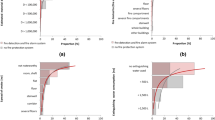Abstract
The first version of a method for predicting the hazards to occupants involved in a building fire is described. The method and available computer software, called HAZARDI, can predict the time varying environment within a building resulting from a specified fire; the locations and actions of occupants; and the impact of the exposure of each of the occupants to the fire products in terms of whether the occupants successfully escape, are incapacitated, or are killed.
Similar content being viewed by others
References
Bukowski, R. B., Peacock, R. D., Jones, W.W., & Forney, C.L., “Technical Reference Guide for the HAZARD I Fire Hazard Assessment Method,” Handbook 146 Volume II, U.S. National Institute of Standards and Technology, Gaithersburg, MD (1989).
Bukowski, R. B., Peacock, R. D., Jones, W. W., & Forney, C. L., “Software User's Guide for the HAZARD I Fire Hazard Assessment Method,” Handbook 146 Volume I, National Institute of Standards and Technology (1989).
Bukowski, R. B., Peacock, R. D., Jones, W. W., & Forney, C. L., “Software User's Guide for the HAZARD I Fire Hazard Assessment Method,” Handbook 146 Volume III, National Institute of Standards and Technology (1989).
Snell, J. E., Levin, B. C., & Fowell, A. J., “Workshop on Combustion Product Toxicology, Summary of Presentations,” September 10, 1982, U. S. National Bureau of Standards, NBSIR 82-2634 (1982).
Snell, J.E., “Hazard Assessment—Challenge to Fire Science,”J. Fire Science, 1 pp. 4–8 (1983).
Lyons, J.W., “Statement of Dr. John W. Lyons before the Senate Committee on Labor and Human Resources,” Hearing on Fire Safety Issues, July 19, 1983.
“Proceedings of NFPA Toxicity Advisory Committee Workshop on Practical Approaches for Smoke Toxicity Hazard Assessment,” National Fire Protection Association, Batterymarch Park, Quincy, MA (February 1984).
Snell, J.E., et al., “Summary Preliminary Report of the Advisory Committee on the Toxicity of the Products of Combustion,” National Fire Protection Association, Batterymarch Park, Quincy, MA, pp. 1–24 (June 1984).
Bukowski, R. W., & Jones, W. W., “The Development of a Method for Assessing Toxic Hazard,”Fire Journal, 79, 2, (1985).
Bukowski, R. W., “Quantitative Determination of Smoke Toxicity Hazard—A Practical Approach for Current Use,”Fire Safety Science—Proceedings of the First International Symposium Hemisphere Publishing Corp., NY (1986).
Bukowski, R.W., “Straw Man Procedure for Assessing Toxic Hazard,” inSummary: A Preliminary Report of the Advisory Committee on the Toxicity of the Products of Combustion National Fire Protection Association, Batterymarch Park, Quincy, MA (1984).
Lawson, J.R., & Quintiere, J. G., “Slide-Rule Estimates of Fire Growth,” National Bureau of Standards, NBSIR 85-3196 (1985).
Bukowski, R. W., “Toxic Hazard Evaluation of Plenum Cables,”Fire Technology 21 4 252–266 (1985).
Cooper, L.Y., “A Mathematical Model for Estimating Available Safe Egress Time in Fires,”Fire and Materials 6 3 and4, 135–144 (1982).
Babrauskas, V., “COMPF2—A Program for Calculating Post-flashover Fire Temperatures,” National Bureau of Standards Tech. Note 991 (1979).
Mitler, H.E., “Jefferson National Memorial Historical Site Analysis of Impact of Fire Safety Features,” National Bureau of Standards MBSOR 84-2897 (1985).
Tanaka, T., “A Model of Multiroom Fire Spread,” National Bureau of Standards, NBSIR 83-2718 (1983).
Gahm, J. B., “Computer Fire Code VI, Volume I,” National Bureau of Standards, NBS GCR 83-451 (1983).
Nelson, H. E., “Jefferson National Memorial Historical Site Analysis of Impact of Fire Safety Features,” National Bureau of Standards, NBSIR 84-2897 (1985).
Bukowski, R. W., “Evaluation of Furniture Fire Hazard Using a Hazard-Assessment Computer Model,”Fire and Materials 9 4 pp. 159–166 (1985).
Emmons, H. W., “Why Fire Model? The MGM Fire and Toxicity Testing,” The 1985 SFPE Guise Award Lecture, Harvard/FMRC Home Fire Project Technical Report No. 73 (1985).
“Fire & Smoke: Understanding the Hazards,” Committee on Fire Toxicology, U.S. National Research Council, National Academy of Sciences; Washington, DC; National Academy Press, pp. 105–130 (July 1986).
Bukowski, R.W., “HAZARD I—Results of a User Evaluation of the Prototype Software,” NISTIR 88-3878, National Institute of Standards and Technology, Gaithersburg, MD 20899 (1988)
Gross, D., “The Use of Fire Statistics in Assessing the Fire Risk of Products,” inInterflame 1985 Conference Workbook, pp. 26–28, 11–18 (1985).
Karter, M. J., Jr., “Fire Loss in the United States During 1984,”Fire Journal 79 3 pp. 67–76 (1985).
Jones, W. W., & Peacock, R. D., “Technical Reference Guide for FAST Version 18, Tech. Note 1262, National Institute of Standards and Technology, Gaithersburg, MD 20899 (1989).
Jones, W. W., & Peacock, R. D., “Refinement and Experimental Verification of a Model for Fire Growth and Smoke Transport,”Proceedings of the Second Annual Symposium on Fire Safety Science, Tokyo, Japan, Hemisphere Publishing Co., NY (1989).
Levin, B. C., Paabo, M., Gurman, J. L., Clark, H. M., & Yoklavich, M. F., “Further Studies of the Toxicological Effects of Different Time Exposures to the Individual and Combined Fire Gases—Carbon Monoxide, Hydrogen Cyanide, Carbon Dioxide and Reduced Oxygen,”Polyurethanes '88, Proceedings of the 31st Meeting of the Society of Plastics Industry, Philadelphia, PA, Technomic Publishing, Lancaster, PA (1988).
Babrauskas, V., Levin, B. C., & Gann, R. G., “A New Approach to Fire Toxicity Data for Hazard Evaluation,”ASTM Standardization News 14 9 pp. 28–33 (1986).
Hartzell, G. E., Swirzer, W. G., & Priest, D. N., “Mathematical Modeling of Toxicological Effects of Fire Gases,”Journal of Fire Science 3 330–342 (1985).
Purser, D. A., “Toxicity Assessment of Combustion Products,” inSFPE Handbook of Fire Protection Engineering National Fire Protection Association, Batterymarch Park, Quincy, MA (1988).
Klote, J. H., “A Computer Model of Smoke Movement by Air Conditioning Systems (SMACS),” NBSIR 87-3657, National Bureau of Standards, Gaithersburg, MD 20899 (1987).
Author information
Authors and Affiliations
Additional information
This paper is a contribution of the U.S. National Institute of Standards and Technology (formerly National Bureau of Standards) and is not subject to copyright.
Rights and permissions
About this article
Cite this article
Peacock, R.D., Bukowski, R.W. A prototype methodology for fire hazard analysis. Fire Technol 26, 15–40 (1990). https://doi.org/10.1007/BF01040188
Issue Date:
DOI: https://doi.org/10.1007/BF01040188



